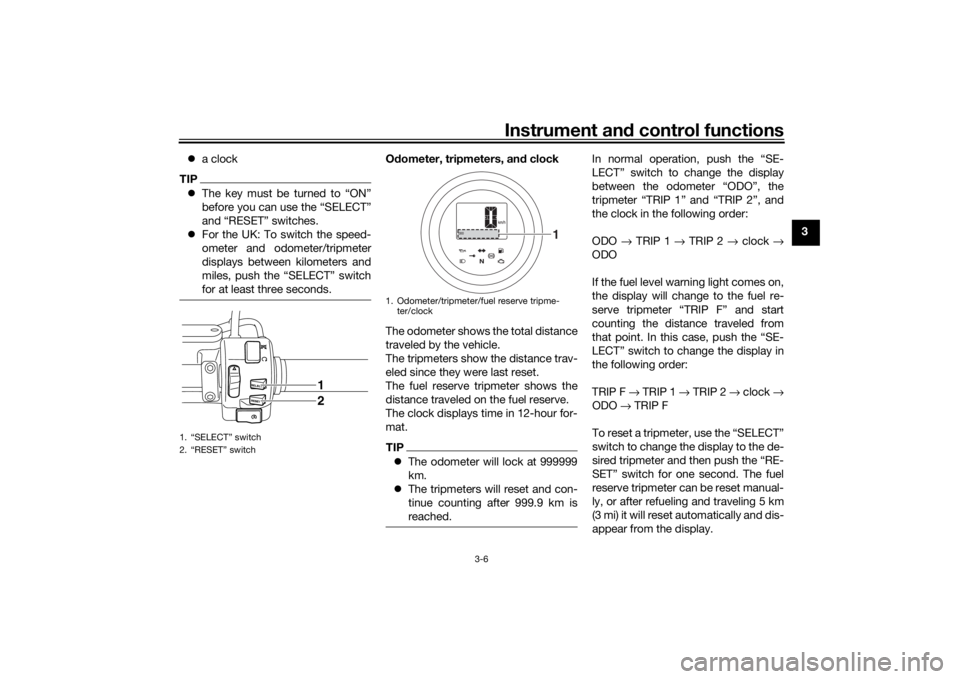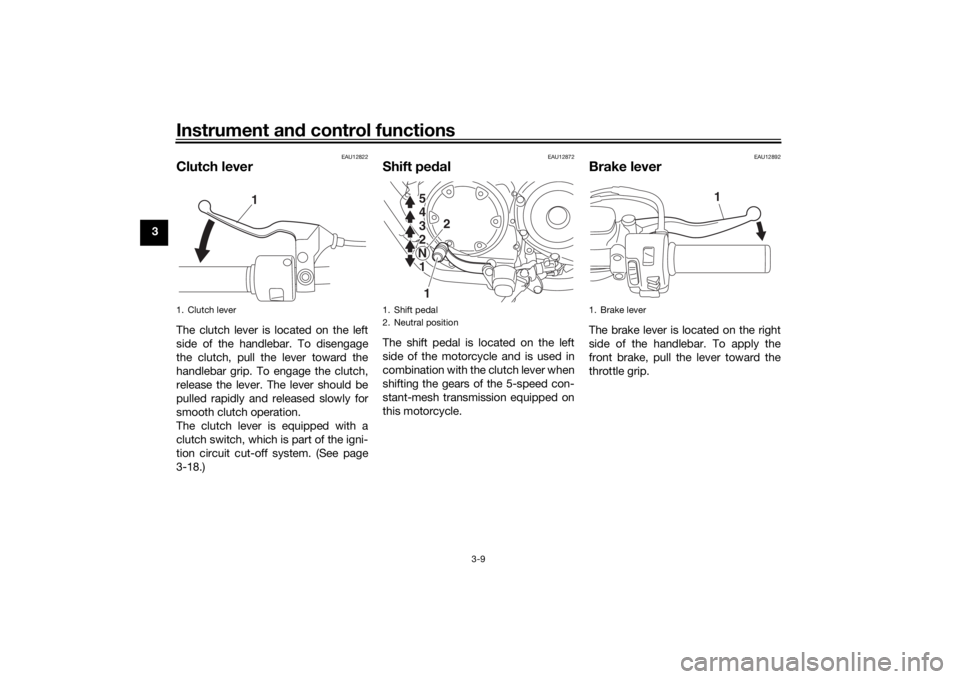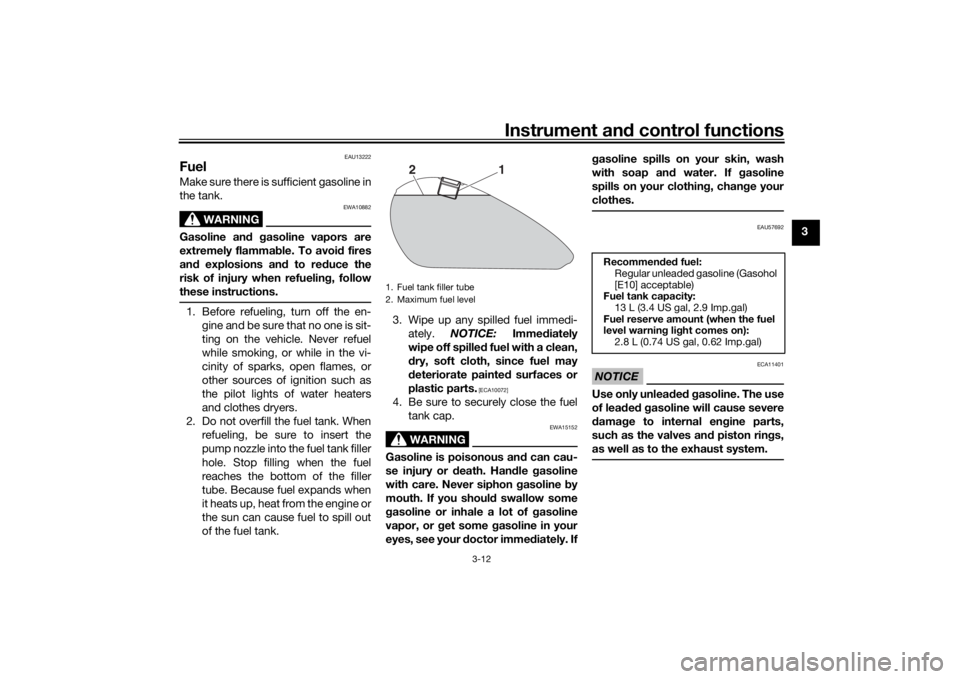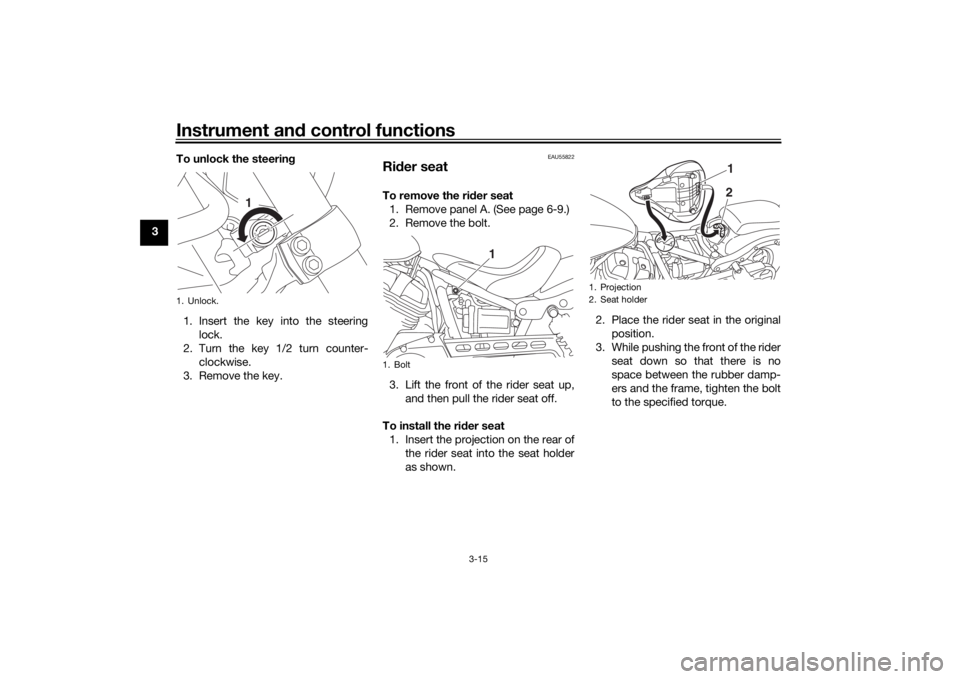YAMAHA XVS950CU 2017 Owner's Manual
Manufacturer: YAMAHA, Model Year: 2017, Model line: XVS950CU, Model: YAMAHA XVS950CU 2017Pages: 88, PDF Size: 2.38 MB
Page 21 of 88

Instrument and control functions
3-6
3
a clock
TIPThe key must be turned to “ON”
before you can use the “SELECT”
and “RESET” switches.
For the UK: To switch the speed-
ometer and odometer/tripmeter
displays between kilometers and
miles, push the “SELECT” switch
for at least three seconds.
Odometer, tripmeters, an d clock
The odometer shows the total distance
traveled by the vehicle.
The tripmeters show the distance trav-
eled since they were last reset.
The fuel reserve tripmeter shows the
distance traveled on the fuel reserve.
The clock displays time in 12-hour for-
mat.TIP The odometer will lock at 999999
km.
The tripmeters will reset and con-
tinue counting after 999.9 km is
reached.
In normal operation, push the “SE-
LECT” switch to change the display
between the odometer “ODO”, the
tripmeter “TRIP 1” and “TRIP 2”, and
the clock in the following order:
ODO → TRIP 1 → TRIP 2 → clock →
ODO
If the fuel level warning light comes on,
the display will change to the fuel re-
serve tripmeter “TRIP F” and start
counting the distance traveled from
that point. In this case, push the “SE-
LECT” switch to change the display in
the following order:
TRIP F → TRIP 1 → TRIP 2 → clock →
ODO → TRIP F
To reset a tripmeter, use the “SELECT”
switch to change the display to the de-
sired tripmeter and then push the “RE-
SET” switch for one second. The fuel
reserve tripmeter can be reset manual-
ly, or after refueling and traveling 5 km
(3 mi) it will reset automatically and dis-
appear from the display.
1. “SELECT” switch
2. “RESET” switch
1
2
1. Odometer/tripmeter/fuel reserve tripme- ter/clock
1
UBS5E0E0.book Page 6 Wednesday, October 19, 2016 10:21 AM
Page 22 of 88

Instrument and control functions
3-7
3 To set the clock
1. Push the “SELECT” and “RESET”
switches for three seconds. The
hour digits will start flashing.
2. Use the “SELECT” switch to set the hours.
3. Push the “RESET” switch. The mi- nute digits will start flashing.
4. Use the “SELECT” switch to set the minutes.
5. Push the “RESET” switch for two seconds to confirm setting chang-
es and start the clock.
EAU1234M
Han dle bar switchesLeft Ri
ght
EAU12352
Pass switch “ ”
Press this switch to flash the headlight.TIPWhen the dimmer switch is set
to “ ”, the passing switch has no ef-
fect.
EAU12401
Dimmer switch “ / ”
Set this switch to “ ” for the high
beam and to “ ” for the low beam.
1. Clock
1
1. Pass switch “ ”
2. Dimmer switch “ / ”
3. Turn signal switch “ / ”
4. Horn switch “ ”
3
4 12
1. Engine stop switch “ / ”
2. “SELECT” switch
3. “RESET” switch
4. Start switch “ ”
5. Hazard switch “ ”
1
5 2
3
4
UBS5E0E0.book Page 7 Wednesday, October 19, 2016 10:21 AM
Page 23 of 88

Instrument and control functions
3-8
3
EAU12461
Turn si gnal switch “ / ”
To signal a right-hand turn, push this
switch to “ ”. To signal a left-hand
turn, push this switch to “ ”. When
released, the switch returns to the cen-
ter position. To cancel the turn signal
lights, push the switch in after it has re-
turned to the center position.
EAU12501
Horn switch “ ”
Press this switch to sound the horn.
EAU12662
En gine stop switch “ / ”
Set this switch to “ ” before starting
the engine. Set this switch to “ ” to
stop the engine in case of an emergen-
cy, such as when the vehicle overturns
or when the throttle cable is stuck.
EAU12713
Start switch “ ”
Push this switch to crank the engine
with the starter. See page 5-1 for start-
ing instructions prior to starting the en-
gine.
EAU12735
Hazar d switch “ ”
With the key in the “ON” or “ ” posi-
tion, use this switch to turn on the haz-
ard lights (simultaneous flashing of all
turn signal lights).
The hazard lights are used in case of an
emergency or to warn other drivers
when your vehicle is stopped where it
might be a traffic hazard.NOTICE
ECA10062
Do not use the hazar d lig hts for an
exten ded len gth of time with the en-
g ine not runnin g, otherwise the bat-
tery may d ischarge.
EAU55701
“SELECT” switch
This switch is used to perform selec-
tions in the odometer and tripmeters
and to set the clock of the multi-func-
tion meter unit.
See “Multi-function meter unit” on
page 3-5 for detailed information.
EAU55711
“RESET” switch
This switch is used to reset the tripme-
ters and to set the clock of the multi-
function meter unit.
See “Multi-function meter unit” on
page 3-5 for detailed information.
UBS5E0E0.book Page 8 Wednesday, October 19, 2016 10:21 AM
Page 24 of 88

Instrument and control functions
3-9
3
EAU12822
Clutch leverThe clutch lever is located on the left
side of the handlebar. To disengage
the clutch, pull the lever toward the
handlebar grip. To engage the clutch,
release the lever. The lever should be
pulled rapidly and released slowly for
smooth clutch operation.
The clutch lever is equipped with a
clutch switch, which is part of the igni-
tion circuit cut-off system. (See page
3-18.)
EAU12872
Shift pe dalThe shift pedal is located on the left
side of the motorcycle and is used in
combination with the clutch lever when
shifting the gears of the 5-speed con-
stant-mesh transmission equipped on
this motorcycle.
EAU12892
Brake leverThe brake lever is located on the right
side of the handlebar. To apply the
front brake, pull the lever toward the
throttle grip.
1. Clutch lever
1
1. Shift pedal
2. Neutral position
1
2
5
4
3
2
N 1 5
4
3
2
N 1
1. Brake lever
1
UBS5E0E0.book Page 9 Wednesday, October 19, 2016 10:21 AM
Page 25 of 88

Instrument and control functions
3-10
3
EAU12944
Brake ped alThe brake pedal is located on the right
side of the motorcycle. To apply the
rear brake, press down on the brake
pedal.
EAU63040
ABSThe Yamaha ABS (Anti-lock Brake
System) features a dual electronic con-
trol system, which acts on the front and
rear brakes independently.
Operate the brakes with ABS as you
would conventional brakes. If the ABS
is activated, a pulsating sensation may
be felt at the brake lever or brake ped-
al. In this situation, continue to apply
the brakes and let the ABS work; do
not “pump” the brakes as this will re-
duce braking effectiveness.
WARNING
EWA16051
Always keep a sufficient d istance
from the vehicle ahea d to match the
ri din g speed even with ABS.
The ABS performs best with
lon g b rakin g d istances.
On certain surfaces, such as
rou gh or g ravel roa ds, the b rak-
in g d istance may be lon ger with
the ABS than without.The ABS is monitored by an ECU,
which will revert the system to conven-
tional braking if a malfunction occurs.
TIP The ABS performs a self-diagno-
sis test each time the vehicle first
starts off after the key is turned to
“ON” and the vehicle has traveled
at a speed of 10 km/h (6 mi/h) or
higher. During this test, a “click-
ing” noise can be heard from the
hydraulic control unit, and if the
brake lever or brake pedal is even
slightly applied, a vibration can be
felt at the lever and pedal, but
these do not indicate a malfunc-
tion.
This ABS has a test mode which
allows the owner to experience
the pulsation at the brake lever or
brake pedal when the ABS is op-
erating. However, special tools are
required, so please consult your
Yamaha dealer.NOTICE
ECA20100
Be careful not to d amage the wheel
sensor or wheel sensor rotor; other-
wise, improper performance of the
ABS will result.
1. Brake pedal
1
UBS5E0E0.book Page 10 Wedne sday, October 19, 2016 10:21 AM
Page 26 of 88

Instrument and control functions
3-11
3
EAU13125
Fuel tank capTo remove the fuel tank cap
Slide the fuel tank cap lock cover open,
insert the key into the lock, and then
turn it 1/4 turn clockwise. The lock will
be released and the fuel tank cap can
be removed.
To install the fuel tank cap
1. Insert the fuel tank cap into the tank opening with the key inserted
in the lock and with the “ ” mark
facing forward. 2. Turn the key counterclockwise to
the original position, remove it,
and then close the lock cover.
TIPThe fuel tank cap cannot be installed
unless the key is in the lock. In addi-
tion, the key cannot be removed if the
cap is not properly installed and
locked.
WARNING
EWA10132
Make sure that the fuel tank cap is
properly installe d before ri din g.
Leakin g fuel is a fire hazar d.
1. Front wheel sensor rotor
2. Front wheel sensor
1. Rear wheel sensor rotor
2. Rear wheel sensor1
21
2
1. Fuel tank cap lock cover
2. “ ” mark
3. Lock.
4. Unlock.1
2 4
3
UBS5E0E0.book Page 11 Wedne
sday, October 19, 2016 10:21 AM
Page 27 of 88

Instrument and control functions
3-12
3
EAU13222
FuelMake sure there is sufficient gasoline in
the tank.
WARNING
EWA10882
Gasoline an d gasoline vapors are
extremely flammab le. To avoid fires
an d explosions an d to re duce the
risk of injury when refuelin g, follow
these instructions.1. Before refueling, turn off the en- gine and be sure that no one is sit-
ting on the vehicle. Never refuel
while smoking, or while in the vi-
cinity of sparks, open flames, or
other sources of ignition such as
the pilot lights of water heaters
and clothes dryers.
2. Do not overfill the fuel tank. When refueling, be sure to insert the
pump nozzle into the fuel tank filler
hole. Stop filling when the fuel
reaches the bottom of the filler
tube. Because fuel expands when
it heats up, heat from the engine or
the sun can cause fuel to spill out
of the fuel tank. 3. Wipe up any spilled fuel immedi-
ately. NOTICE: Immediately
wipe off spille d fuel with a clean,
d ry, soft cloth, since fuel may
d eteriorate painte d surfaces or
plastic parts.
[ECA10072]
4. Be sure to securely close the fuel tank cap.
WARNING
EWA15152
Gasoline is poisonous an d can cau-
se injury or death. Han dle gasoline
with care. Never siphon gasoline by
mouth. If you shoul d swallow some
g asoline or inhale a lot of gasoline
vapor, or get some g asoline in your
eyes, see your d octor immediately. If g
asoline spills on your skin, wash
with soap an d water. If g asoline
spills on your clothin g, chan ge your
clothes.
EAU57692
NOTICE
ECA11401
Use only unlea ded g asoline. The use
of lead ed g asoline will cause severe
d amag e to internal en gine parts,
such as the valves an d piston rin gs,
as well as to the exhaust system.
1. Fuel tank filler tube
2. Maximum fuel level
2
1
Recommen ded fuel:
Regular unleaded gasoline (Gasohol
[E10] acceptable)
Fuel tank capacity:
13 L (3.4 US gal, 2.9 Imp.gal)
Fuel reserve amount (when the fuel
level warnin g li ght comes on):
2.8 L (0.74 US gal, 0.62 Imp.gal)
UBS5E0E0.book Page 12 Wedne sday, October 19, 2016 10:21 AM
Page 28 of 88

Instrument and control functions
3-13
3
TIPThis mark identifies the recom-
mended fuel for this vehicle as
specified by European regulation
(EN228).
Check that gasoline nozzle has
the same identifier when fueling.Your Yamaha engine has been de-
signed to use regular unleaded gaso-
line with a research octane number of
95 or higher. If knocking (or pinging)
occurs, use a gasoline of a different
brand or premium unleaded fuel. Use
of unleaded fuel will extend spark plug
life and reduce maintenance costs. Gasohol
There are two types of gasohol: gaso-
hol containing ethanol and that con-
taining methanol. Gasohol containing
ethanol can be used if the ethanol con-
tent does not exceed 10% (E10). Gas-
ohol containing methanol is not
recommended by Yamaha because it
can cause damage to the fuel system
or vehicle performance problems.
EAU77630
Fuel tank breather/overflow
hoseBefore operating the motorcycle:
Check the fuel tank breather/over-
flow hose connections.
Check the hose for cracks or dam-
age, and replace it if necessary.
Make sure that the canister
breather is not blocked, and clean
it if necessary.TIPSee page 6-11 for canister information.
E5
E10
1. Fuel tank breather/overflow hose
1
UBS5E0E0.book Page 13 Monday, May 21, 2018 5:59 PM
Page 29 of 88

Instrument and control functions
3-14
3
EAU13434
Catalytic converterThis model is equipped with a catalytic
converter in the exhaust system.
WARNING
EWA10863
The exhaust system is hot after op-
eration. To prevent a fire hazar d or
b urns:
Do not park the vehicle near
possi ble fire hazar ds such as
g rass or other materials that
easily burn.
Park the vehicle in a place
where pe destrians or chil dren
are not likely to touch the hot
exhaust system.
Make sure that the exhaust sys-
tem has coole d down before
d oin g any maintenance work.
Do not allow the en gine to i dle
more than a few minutes. Lon g
i d lin g can cause a buil d-up of
heat.
NOTICE
ECA10702
Use only unlea ded g asoline. The use
of lead ed g asoline will cause unre-
paira ble damag e to the catalytic
converter.
EAU55663
Steerin g lockThe steering lock is located on the right
side of the vehicle between the upper
and lower steering brackets.
To lock the steerin g
1. Turn the handlebar all the way to the left.
2. Insert the key into the steering lock and turn it 1/2 turn clockwise.
3. Remove the key from the lock.TIPIf the steering lock is difficult to en-
gage, try turning the handlebars back
to the right slightly.1. Steering lock
2. Lock.
L O CKUNLO CK
1
2
UBS5E0E0.book Page 14 Wedne
sday, October 19, 2016 10:21 AM
Page 30 of 88

Instrument and control functions
3-15
3 To unlock the steerin
g
1. Insert the key into the steering lock.
2. Turn the key 1/2 turn counter- clockwise.
3. Remove the key.
EAU55822
Ri der seatTo remove the ri der seat
1. Remove panel A. (See page 6-9.)
2. Remove the bolt.
3. Lift the front of the rider seat up, and then pull the rider seat off.
To install the ri der seat
1. Insert the projection on the rear of the rider seat into the seat holder
as shown. 2. Place the rider seat in the original
position.
3. While pushing the front of the rider seat down so that there is no
space between the rubber damp-
ers and the frame, tighten the bolt
to the specified torque.
1. Unlock.
LO CKUNLO CK
1
1. Bolt
1
1. Projection
2. Seat holder
21
UBS5E0E0.book Page 15 Wedne sday, October 19, 2016 10:21 AM